Backert Labs Rhythm 1.4 tube preamplifier By Terry London
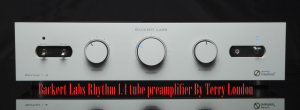
 I have been a long-time admirer of Backert Labs, which is located in Hockessin, Delaware. This company exclusively designs and hand-builds reference-level, in both the quality of internal components and chassis materials, some of the highest-performing tube-based line stages found on the market today. Their different-level preamplifiers are not inexpensive, but they are very reasonably priced and compete with line-stages that are exponentially more expensive. Historically, my first experience with Backert Labs was in 2015, when I reviewed the Rhythm 1.1 preamplifier, which cost $7,500. At that time, my reference line stage was the universally praised Concert Fidelity-080, which was hand-built in Japan and sold for $24,000. I was quite shocked that the far less expensive Backert Labs Rhythm 1.1 preamplifier easily matched the performance of the outstanding Concert Fidelity 080 and surpassed it in its rendering of spatial dimensions and overall dynamics/transient speed. Bob Backert is the CEO and designer of Backert Labs and is highly respected for his innovations in power supply and circuit design. An example of his ingenuity is the U.S.-patented “Greenforce” power supply, which uniquely utilizes Teflon capacitors —a feature also found in the subject of this review, the Backert Labs reference preamplifier, the Rhythm 1.4, which retails for $12,900. Another critical team member of Backert Labs is Andy Tebbe. A lifelong musician and audiophile, he provides input on voicing and sound quality on all Backert Labs preamplifiers. Bob’s son, Gary Backert, handles construction and the admirably clean circuit board layout.
I have been a long-time admirer of Backert Labs, which is located in Hockessin, Delaware. This company exclusively designs and hand-builds reference-level, in both the quality of internal components and chassis materials, some of the highest-performing tube-based line stages found on the market today. Their different-level preamplifiers are not inexpensive, but they are very reasonably priced and compete with line-stages that are exponentially more expensive. Historically, my first experience with Backert Labs was in 2015, when I reviewed the Rhythm 1.1 preamplifier, which cost $7,500. At that time, my reference line stage was the universally praised Concert Fidelity-080, which was hand-built in Japan and sold for $24,000. I was quite shocked that the far less expensive Backert Labs Rhythm 1.1 preamplifier easily matched the performance of the outstanding Concert Fidelity 080 and surpassed it in its rendering of spatial dimensions and overall dynamics/transient speed. Bob Backert is the CEO and designer of Backert Labs and is highly respected for his innovations in power supply and circuit design. An example of his ingenuity is the U.S.-patented “Greenforce” power supply, which uniquely utilizes Teflon capacitors —a feature also found in the subject of this review, the Backert Labs reference preamplifier, the Rhythm 1.4, which retails for $12,900. Another critical team member of Backert Labs is Andy Tebbe. A lifelong musician and audiophile, he provides input on voicing and sound quality on all Backert Labs preamplifiers. Bob’s son, Gary Backert, handles construction and the admirably clean circuit board layout.
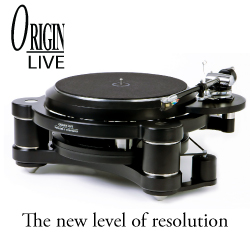 I have two firm opinions regarding the performance of tube-based preamplifiers. First, a world-class tube-based preamplifier should be completely transparent, presenting only the signature of the signal tubes being used. This test evaluates both designers’ talents in driving the signal or buffer tubes to allow them to “sing” their unique perspective on the music, along with their ability to design power supplies that produce the dynamics found in live music while minimizing the noise floor to an almost imperceptible degree. Secondly, if you pair a reference-level tube-based preamplifier with an excellent solid-state power amplifier, typically in my experience, a Class A design, you should get all the special qualities of color, tonality, and spatiality of tubes virtually while retaining the bass control and overall regulation of the speaker’s operation that solid-state provides. I have had many terrific tube-based amplifiers in my systems over the years, and I have never had any issues regarding dependability, re-tubing, or heat problems. After lengthy experimentation over the years, I have concluded that a combo of a world-class tube line-stage with a great solid-state amplifier gets me so close to what I want tubes to do in my system that a tube-based power amplifier is not necessary. During my review process, the combination of the Backert Labs Rhythm 1.4 and my refurbished Plinius SA-50 amplifier took my system to new heights of engagement and musicality.
I have two firm opinions regarding the performance of tube-based preamplifiers. First, a world-class tube-based preamplifier should be completely transparent, presenting only the signature of the signal tubes being used. This test evaluates both designers’ talents in driving the signal or buffer tubes to allow them to “sing” their unique perspective on the music, along with their ability to design power supplies that produce the dynamics found in live music while minimizing the noise floor to an almost imperceptible degree. Secondly, if you pair a reference-level tube-based preamplifier with an excellent solid-state power amplifier, typically in my experience, a Class A design, you should get all the special qualities of color, tonality, and spatiality of tubes virtually while retaining the bass control and overall regulation of the speaker’s operation that solid-state provides. I have had many terrific tube-based amplifiers in my systems over the years, and I have never had any issues regarding dependability, re-tubing, or heat problems. After lengthy experimentation over the years, I have concluded that a combo of a world-class tube line-stage with a great solid-state amplifier gets me so close to what I want tubes to do in my system that a tube-based power amplifier is not necessary. During my review process, the combination of the Backert Labs Rhythm 1.4 and my refurbished Plinius SA-50 amplifier took my system to new heights of engagement and musicality.
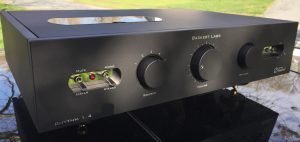
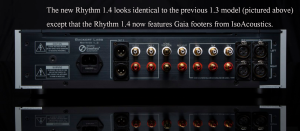
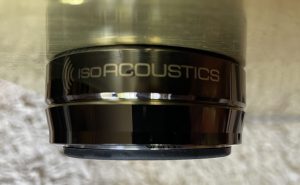 The Backert Labs Rhythm 1.4 preamplifier sent to me for review was the black version. You can also get the Rhythm 1.4 in a satin silver finish. The chassis is milled out of solid aluminum billet. The bottom plate is a thick panel of solid brass. Andy Tebbe explained that, after thorough testing, the solid brass plate produced audible positive changes compared to the standard aluminum plate in the Rhythm 1.4 preamplifiers’ overall musicality. The Rhythm 1.4 weighs 29 pounds. The footers for the 1.4s are “Gaia” feet from Iso Acoustics [photo right]. On the front plate, you find three toggle switches for muting, mono/stereo, and on/off. There are three knobs for controlling the input source, volume control, and channel balance. The remote control is made of thick aluminum and controls the volume with precision and smoothness, also allowing users to mute the preamp. A small blue LED is embedded on the outside of the volume control knob, allowing you to easily see the volume level from your seating position. On the back of the Rhythm 1.4 are two fully balanced XLR outputs, two fully balanced XLR inputs, three REC inputs, and two RCA outputs, along with the IEC connector. Backert also includes a record-out RCA pair and a home theater bypass input.
The Backert Labs Rhythm 1.4 preamplifier sent to me for review was the black version. You can also get the Rhythm 1.4 in a satin silver finish. The chassis is milled out of solid aluminum billet. The bottom plate is a thick panel of solid brass. Andy Tebbe explained that, after thorough testing, the solid brass plate produced audible positive changes compared to the standard aluminum plate in the Rhythm 1.4 preamplifiers’ overall musicality. The Rhythm 1.4 weighs 29 pounds. The footers for the 1.4s are “Gaia” feet from Iso Acoustics [photo right]. On the front plate, you find three toggle switches for muting, mono/stereo, and on/off. There are three knobs for controlling the input source, volume control, and channel balance. The remote control is made of thick aluminum and controls the volume with precision and smoothness, also allowing users to mute the preamp. A small blue LED is embedded on the outside of the volume control knob, allowing you to easily see the volume level from your seating position. On the back of the Rhythm 1.4 are two fully balanced XLR outputs, two fully balanced XLR inputs, three REC inputs, and two RCA outputs, along with the IEC connector. Backert also includes a record-out RCA pair and a home theater bypass input.
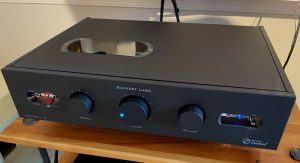
At the top is what I call the “tube bay.” With an easy-to-remove plexiglass cover, the pair of 12AU7 tubes is accessible, making tube rolling a breeze. Backert Labs ships the Rhythm 1.4 with vintage American-made tubes, which are significantly higher in performance than the great majority of current production tubes. For more details on the choice of and types of internal parts, circuit topography, power supply details, and other performance specifications, I highly recommend visiting the informative Backert Labs website.
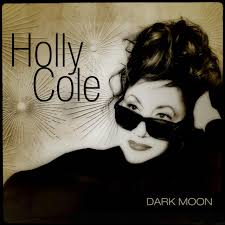 With the first musical notes from singer Holly Cole’s album “Dark Moon,” with the Backert Labs Rhythm 1.4 preamplifier controlling the system, I knew I was in for a lot of musical pleasure. With a pair of 1956 CV491 Long Plate Mullards in the Rhythm 1.4, the illusion that a life-size holographic Ms. Cole was standing and singing in my room was somewhat startling but remarkable! Also, that creamy, timbre-rich mid-band that these British tubes are famous for making her unique and seductive voice sound the most “real” I had ever heard in my system.
With the first musical notes from singer Holly Cole’s album “Dark Moon,” with the Backert Labs Rhythm 1.4 preamplifier controlling the system, I knew I was in for a lot of musical pleasure. With a pair of 1956 CV491 Long Plate Mullards in the Rhythm 1.4, the illusion that a life-size holographic Ms. Cole was standing and singing in my room was somewhat startling but remarkable! Also, that creamy, timbre-rich mid-band that these British tubes are famous for making her unique and seductive voice sound the most “real” I had ever heard in my system.
My next musical selection was Bob Marley’s “Is This Love,” which was recorded in a large outdoor arena. I use this cut to evaluate a preamplifier’s ability with two spatial qualities: 1) How it replicates the height, width, and depth of the soundstage. Also, how does it locate the individual player’s position on that stage? Does it provide “air” around the players, giving them a sense of three-dimensional imaging? 2) What I 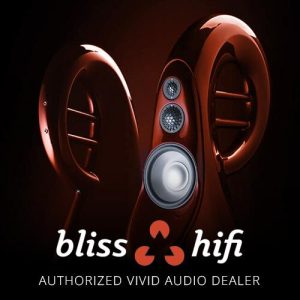 have recently started calling “sound space” are the ambient cues, reflections, and reverbs of the acoustic space in which the music was recorded. This gives you cues, not of the music, but allows you to know if it was recorded in a studio, a symphonic hall, a small jazz club, a church, or an outdoor arena. In a world-class preamplifier, if the rest of your system is up to it, your engagement with the music will dramatically increase because you will easily hear both the music and the space in which it was recorded. For this selection, I inserted my pair of 1958 12AU7 tubes, made in Holland by Amperex, into the Rhythm 1.4. These tubes are renowned for their natural, open, airy spatiality and refinement in micro-details, as well as their top-end air. The illusion that I was located in this open outdoor venue was quite remarkable.
have recently started calling “sound space” are the ambient cues, reflections, and reverbs of the acoustic space in which the music was recorded. This gives you cues, not of the music, but allows you to know if it was recorded in a studio, a symphonic hall, a small jazz club, a church, or an outdoor arena. In a world-class preamplifier, if the rest of your system is up to it, your engagement with the music will dramatically increase because you will easily hear both the music and the space in which it was recorded. For this selection, I inserted my pair of 1958 12AU7 tubes, made in Holland by Amperex, into the Rhythm 1.4. These tubes are renowned for their natural, open, airy spatiality and refinement in micro-details, as well as their top-end air. The illusion that I was located in this open outdoor venue was quite remarkable.
Finally, I wanted to see if the Backert Labs Rhythm 1.4 preamplifier could handle powerful bass extension and microdynamics, bringing the speed and aliveness of an electric guitar and Hammond B-3 organ to the music experience. I cued up tenor saxophonist Ron Blake’s album “Lest we forget,” which features the great Joey Defrancesco on the B-3 organ and David Gilmore on guitar. This music features large dynamic swings, and the Hammond B-3 organ bass pedal runs deep with powerful and taut pressurization. I rolled in the Rhythm 1.4, my pair of 1955 12AU7 Smooth Plate Telefunken tubes, which are renowned for their speed, clarity, top-end extension, and linear presentation. This tube is not romantic, warm, or euphonic in any way. If you only want what’s on the recording, this tube is for you. The Backert Labs Rhythm 1.4 preamplifier nailed all the power, drive, and PRaT in the music, delivering the bass frequencies with accurate timbres and the right amount of weight in the B-3 organ bass pedals in a controlled manner.
 The Backert Labs Rhythm 1.4 preamplifier, the company’s reference model, is not inexpensive at $12,900. However, when you factor in the superlative choice of internal parts, the materials used to construct its chassis, and its innovative power supply, it easily outperforms preamplifiers that cost significantly more; it’s a gem at this price point. I stated at the beginning of the review what my criteria are for what a world-class tube-based preamplifier has to offer: that the line stage disappears from the sonic signature and conveys the musical qualities that tubes bring to the music signal. Secondly, it should have a noise floor that is virtually nonexistent and a power supply that provides dynamics and transient speed, bringing music to life. Nothing in audio is perfect. However, the Backert Labs Rhythm 1.4 preamplifier comes close. Every time I put a different set of tubes into it, it returned beautiful tonality, astonishing spatiality, world-class dynamics, and control over the extension of both top and bottom frequencies. This was all done with an engaging and relaxing quality that, to a certain degree, only tubes provide compared to solid-state preamplifiers. I have an extensive collection of NOS 12AU7 and their equivalents (5814, 5963, 6189) from both famous American and European companies. Regardless of the tube I used, I heard what that tube had to offer in my system. Great fun! Based on what I shared in this review, I decided to purchase the Rhythm 1.4 because I didn’t want to give up the fun and exceptional musical enjoyment it creates in my system.
The Backert Labs Rhythm 1.4 preamplifier, the company’s reference model, is not inexpensive at $12,900. However, when you factor in the superlative choice of internal parts, the materials used to construct its chassis, and its innovative power supply, it easily outperforms preamplifiers that cost significantly more; it’s a gem at this price point. I stated at the beginning of the review what my criteria are for what a world-class tube-based preamplifier has to offer: that the line stage disappears from the sonic signature and conveys the musical qualities that tubes bring to the music signal. Secondly, it should have a noise floor that is virtually nonexistent and a power supply that provides dynamics and transient speed, bringing music to life. Nothing in audio is perfect. However, the Backert Labs Rhythm 1.4 preamplifier comes close. Every time I put a different set of tubes into it, it returned beautiful tonality, astonishing spatiality, world-class dynamics, and control over the extension of both top and bottom frequencies. This was all done with an engaging and relaxing quality that, to a certain degree, only tubes provide compared to solid-state preamplifiers. I have an extensive collection of NOS 12AU7 and their equivalents (5814, 5963, 6189) from both famous American and European companies. Regardless of the tube I used, I heard what that tube had to offer in my system. Great fun! Based on what I shared in this review, I decided to purchase the Rhythm 1.4 because I didn’t want to give up the fun and exceptional musical enjoyment it creates in my system.


Specifications:
The Rhythm 1.4 preamplifier, from Backert Labs
Price: $12,900
Line stage tubed preamp
5 inputs, 4 outputs, 1 “Rec Out”, 1 Home Theater Bypass (2 inputs are fully balanced XLR, 3 inputs are RCA) (2 outputs are fully balanced XLR, 2 are RCA)
Balance control, mute switch, stereo/mono switch, remote volume control with mute button
Tube complement: 2 X 12au7, accessible via tube access door on top panel
Phase: correct phase
Chassis: machined in Pennsylvania from solid aluminum billet; bottom panel supporting the circuit board is solid brass
THD+N: 0.09%
Gain: 10dB
Frequency response: flat within 1.5 dB from 6Hz to 108 kHz
S/N ratio: 98dB (90dB referenced to a 1V output)
Input impedance: 34,000Ω
Output impedance: Below 80Ω
Crosstalk: 78dB
Power consumption, idle: 31W
Dimensions: 17 x 14 x 5 inches
Weight: 29 lbs
Website: https://backertlabs.com/the-rhythm-1-3-linestage-tube-preamplifier/
Terry’s Associated Equipment
Source:
Pass Labs DAC-1
Reimyo DAP-999EX Toku DAC
Mark Levinson 31.5 transport
Pro-Ject reference CD transport & LTA power supply
Wadia 22 transport
CEC t-3 double belt transport
Amplification:
Coda 5.5 amplifier
SPL 1200 amplifier
Plinius SA-50 amplifier
Threshold 550e amplifier
Aric Audio Super SET 300B amplifier
SPL Elector preamplifier
Aric Audio Motherlode MKII preamplifier
Aric Audio Custom 12AX7 preamplifier
Loudspeakers:
Tekton Design Ulfberht
Rosso Fiorentino Arno 40 NSMT System Two
Music Design Knight One
Accessories:
Jena Labs Symphony XLR ICs
Jena Labs Reference AES/EBU digital cable
Vermouth reference speaker cable
Krolo Design reference rack & footers
Puritan Audio power conditioner & grounding master system
Audio Archon power cords
3 thoughts on "Backert Labs Rhythm 1.4 tube preamplifier By Terry London"
Leave a Reply
Stereo Times Masthead
Publisher/Founder
Clement Perry
Editor
Dave Thomas
Senior Editors
Frank Alles, Mike Girardi, Russell Lichter, Terry London, Moreno Mitchell, Paul Szabady, Bill Wells, Mike Wright, and Stephen Yan,
Current Contributors
David Abramson, Tim Barrall, Dave Allison, Ron Cook, Lewis Dardick, John Hoffman, Dan Secula, Don Shaulis, Greg Simmons, Eric Teh, Greg Voth, Richard Willie, Ed Van Winkle, Rob Dockery, Richard Doron, and Daveed Turek
Site Management Clement Perry
Ad Designer: Martin Perry



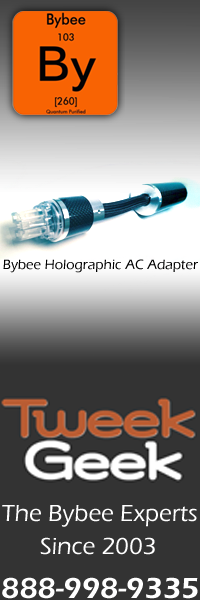
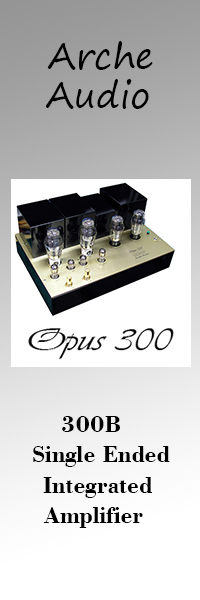
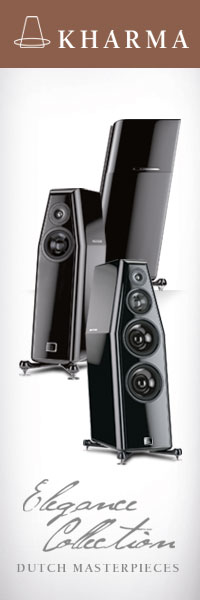
Terry, I’d be interested to hear how it compares to the Aric Audio Motherload XL?
Can you offer additional details on the sound of the “stock” tubes ?
Since owning my rhythm 1.3 (1.4 internals),I have never thought to roll my tubes because the originals that Andy included are such sweet, well-rounded performers. Instead, I have experimented with various higher end cables, since the preamp seems to be so revealing of changes in this realm. After some experimentation with single ended cables coming from my DAC (Synergistic Atmosphere, Core Power Technologies Diamond), I settled on Wywires Platinum balanced, which really satisfy in terms of PRaT and spaciousness.